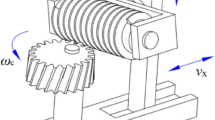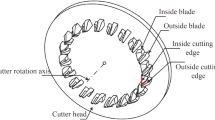Abstract
The cutting area and cutting force are important factors that affect the tool life and the machining performance of the machine tool. According to the characteristics and actual working conditions of hypoid gear processed by generating method, a new method for calculating the tangential milling force of multi-cutter teeth is presented. The changing rule of cutting area of the tooth surface is analyzed, the boundaries of the cutting area, such as the meshing line, the intersection line between the tool tip and the face cone of the wheel blank, the intersection line between the tool tip and the end face of wheel blank, are calculated, and the formula for calculating the cutting area is derived. According to the relationship of the motion and position between the cutting tool and workpiece, the dynamic tangential cutting force is calculated. The calculation of constant cutting force is completed based on the optimization of feed velocity, and an example is introduced to calculate the cutting area and cutting force. The experiment of variable tangential cutting force and constant tangential cutting force is completed, and the accuracy of the dynamic cutting force model is verified.





























Similar content being viewed by others
Abbreviations
- r o :
-
Cutting tool radius
- W 1 :
-
Tool tip distance
- α 1 :
-
Cutting blade profile angle
- u t, φ c :
-
Cutting tool surface coordinates
- φ g1 :
-
Cradle angle
- φ 1 :
-
Workpiece rotation angle
- E 1 :
-
Vertical offset of workpiece
- X B2 :
-
Sliding base
- X G2 :
-
Machine center to back
- γ 1 :
-
Machine root angle
- G a :
-
Distance from face cone vertex to cross point
- θ a :
-
Face angle
- u a, φ a :
-
Surface coordinate of face cone
- G b :
-
Distance from back cone vertex to cross point
- θ b :
-
Back cone angle
- u b, φ b :
-
Back cone surface coordinate
- Db :
-
Diameter of outer circle of the outer end
- t :
-
Actual cutting time
- Δt :
-
The range of time
- n p :
-
Rotating speed of cutting tool
- Z p :
-
Total number of cutting blades
- N :
-
Number of shares of time divided (the time required for the cutting blade to rotate from point X3 to point X1)
- d max :
-
Maximum cutting depth
- h max :
-
Maximum cutting thickness
- s i :
-
Cutting area of each instant
- P b :
-
Fundamental plane
- P c :
-
Cutting edge plane
- P n :
-
Normal plane
- P s :
-
Shear plane
- γ n :
-
Normal rake angle
- ϕ r :
-
Normal shear angle
- τ :
-
Shearing stress
- ξ :
-
Deformation coefficient
- η c :
-
Chip flow angle
- η s :
-
Shear flow angle
- η T :
-
The angle between the plane Pe and the plane Ps
- I :
-
Tool cutting edge inclination angle
- τ :
-
Shearing stress
- b :
-
Cutting thickness
- h :
-
Cutting depth
- β :
-
Friction angle
- V p :
-
Feeding speed
- φ cs :
-
Cutting tool rotation angle
- l pp :
-
Length of the intersection line between the outer cutting tool tip and the wheel blank
- l ec :
-
Length of the intersection line between the inner cutting tool tip and the face cone
- A max :
-
Maximum cutting area
- a :
-
Fitting coefficient
- b :
-
Fitting coefficient
- c :
-
Fitting coefficient
- d :
-
Fitting coefficient
- e :
-
Fitting coefficient
- f :
-
Fitting coefficient
- g :
-
Fitting coefficient
- T :
-
Motor output torque
- F t :
-
Tangential cutting force produced by cutting tool
References
Fan Q (2010) Tooth surface error correction for face-hobbed hypoid gears. J Mech Des 132(1):011004. https://doi.org/10.1115/detc2009-86548
Fan Q (2011) Optimization of face cone element for spiral bevel and hypoid gears. J Mech Des 133(9):091002. https://doi.org/10.1115/1.4004546
Fan Q (2016) Ease-off and application in tooth contact analysis for face-milled and face-hobbed spiral bevel and hypoid gears. Mech Mach Sci 34:321–339. https://doi.org/10.1007/978-3-319-19740-1_15
Shih YP, Fong ZH, Lin GC (2007) Mathematical model for a universal face hobbing hypoid gear generator. J Mech Des 129(1):38–47. https://doi.org/10.1115/1.2359471
Shih YP, Fong ZH (2007) Flank modification methodology for face-hobbing hypoid gears-based on ease-off topography. J Mech Des 129(12):1294–1302. https://doi.org/10.1115/1.2779889
Cao XM, Deng XZ, Wei BY (2018) A novel method for gear tooth contact analysis and experimental validation. Mech Mach Theory 126:1–13. https://doi.org/10.1016/j.mechmachtheory.2018.04.002
Nie SW, Deng J, Deng XZ (2017) Tooth surface topology modification and processing parameters calculation for spiral bevel gears, J. Aerosp Power 32(8):2009–2016
Nie SW, Jiang C, Deng XZ (2019) Flank modification method of hypoid gears with ease off the topology correction. Chin Mech Eng 30(22):1–8
Calleja A, Bo P, González H, Lacalle L (2018) Highly accurate 5-axis flank CNC machining with conical tools. Int J Adv Manuf Technol 97:1605–1615. https://doi.org/10.1007/s00170-018-2033-7
Álvarez A, Calleja A, Ortega N, Lacalle L (2018) Five-axis milling of large spiral bevel gears: toolpath definition, finishing, and shape errors. Metals. 8(353):1–17. https://doi.org/10.3390/met8050353
González H, Calleja A, Pereira O, Lacalle L, Barton M (2018) Super abrasive machining of integral rotary components using grinding flank tools. Metals. 8(24):1–11. https://doi.org/10.3390/met8010024
Bo P, González H, Calleja A, Lacalle L (2020) 5-axis double-flank CNC machining of spiral bevel gears via custom-shaped milling tools — part I: modeling and simulation. Precis Eng 62:204–212. https://doi.org/10.1016/j.precisioneng.2019.11.015
Brumm M, Brecher A, Hardjosuwito F (2013) Analysis and optimization of bevel gear cutting the processes by means of manufacturing simulation. J Simul Model Meth Tech Appl 197:271–284. https://doi.org/10.1007/978-3-642-34336-0_18
Brecher C, Klocke F, Brumm M, Hardjosuwito A (2013) Simulation based model for tool life prediction in bevel gear cutting. Comput Aided Eng 7:223–231. https://doi.org/10.1007/s11740-012-0439-x
Mohsen H, Chen ZC (2016) A semi-analytical approach to un-deformed chip boundary theory and cutting force predication in face-hobbing of bevel gears, Compute. Aided Des 73:53–65. https://doi.org/10.1016/j.cad.2015.12.001
Mohsen H, Chen ZC (2016) An accurate and efficient approach to undeformed chip geometry in face-hobbing and its application in cutting force prediction. J Mech Design 138:023302-1–023302-11. https://doi.org/10.1115/1.4032090
Mohsen H, Chen ZC (2016) Machining setting optimization for formate face-hobbing of bevel gears with the cutting force and tool wear constraints. J Mech Design 138:093301-1–093301-9. https://doi.org/10.1115/1.4033992
Jia XJ, Deng XZ, Su JX (2012) Milling forces model of spiral taper gear using form milling. T Chin Soc Agric Mach 43(12):268–272
Li Q, Liao CJ, Wang R (2012) The research on milling forces of dry cutting spiral bevel gears. Mater Sci Forum 698:213–217. https://doi.org/10.4028/www.scientific.net/msf.697-698.213
Jiang C, Deng XZ, Zhang H (2017) Prediction and simulation of cutting force in hypoid gear machining using forming method. Int J Adv Manuf Technol 93:2471–2483. https://doi.org/10.1007/s00170-017-0656-8
Jia XJ, Deng XZ, Wang B (2013) Rough milling force model of spiral bevel gear using modify-roll method. Chin Mech Eng 24(18):2515–2523
Shi R, Deng XZ, Chuang J (2017) Milling force model of spiral bevel gear milling machine and cutting test. J Sci Technol 38(1):15–20
Russell JK, Brown RH (1966) The measurement of chip flow direction. Int J Mach Tools Manuf 135:129–132. https://doi.org/10.1016/0020-7357(66)90018-7
Li BL, Hu YJ, Wang XL, Li CG (2011) Cutting force predication-based on oblique cutting and found in end milling. Chin Mech Eng 22(19):2283–2288
Funding
The authors gratefully acknowledge the financial support from the National Natural Science Foundation of China (Grant No. 52005157, No. 51705135 and No. 51975185).
Author information
Authors and Affiliations
Corresponding author
Additional information
Publisher’s Note
Springer Nature remains neutral with regard to jurisdictional claims in published maps and institutional affiliations.
Rights and permissions
About this article
Cite this article
Jiang, C., Deng, J. & Deng, X. Optimal calculation and experimental study on cutting force of hypoid gear processed by generating method. Int J Adv Manuf Technol 113, 1615–1635 (2021). https://doi.org/10.1007/s00170-020-06477-2
Received:
Accepted:
Published:
Issue Date:
DOI: https://doi.org/10.1007/s00170-020-06477-2




